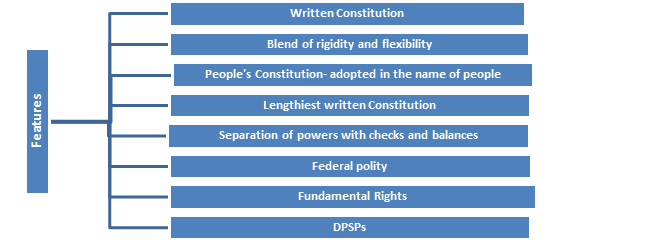Enactment and enforcement
-
- The Constitution was adopted on November 26, 1949, which contained a Preamble, 395 Articles, and 8 Schedules.
- Some provisions related to citizenship, elections, provisional parliament, temporary and transitional provisions, and short title came into force from November 26, 1949.
- The remaining provisions of the Constitution came into force onJanuary 26, 1950, which isrecognized as the ‘date of its commencement’ and celebrated as Republic Day.
Features of the Constitution

Sources of the Constitution
| S.no | Sources | Features borrowed |
|---|---|---|
| Structural sources | ||
| 1. | Government of India Act of 1935 | Federal Scheme, Office of governor, Judiciary, Public Service Commissions, Emergency provisions and administrative details. |
| 2. | Canadian Constitution | Federation with a strong Centre, vesting of residuary powers in the Centre, appointment of state governors by the Centre, and advisory jurisdiction of the Supreme Court. |
| 3. | Australian Constitution | Concurrent List, freedom of trade, commerce and inter-course, and joint sitting of the two Houses of Parliament. |
| Philosophical sources | ||
| 4. | British Constitution | Parliamentary government, Rule of Law, legislative procedure, single citizenship, cabinet system, prerogative writs, parliamentary privileges and bicameralism. |
| 5. | US Constitution | Fundamental rights, independence of judiciary, judicial review, impeachment of the president, removal of Supreme Court and high court judges and post of vice-president. |
| 6. | Irish Constitution | Directive Principles of State Policy, nomination of members to Rajya Sabha and method of election of president. |
| 7. | Japanese Constitution | Procedure established by Law. |
| 8. | Weimar Constitution of Germany | Suspension of Fundamental Rights during Emergency. |
| 9. | Soviet Constitution (USSR, now Russia) | Fundamental duties and the ideal of justice (social, economic and political) in the Preamble. |
| 10. | French Constitution | Republic and the ideals of liberty, equality and fraternity in the Preamble. |
| 11. | South African Constitution | Procedure for amendment of the Constitution and election of members of Rajya Sabha. |
Why constitution is lengthy and cumbersome?
-
- Geographical reasons- the vastness and diversity of the country.
- Historical factors like influence of the Government of India Act of 1935, which was bulky.
- Single Constitution for both the Centre and the states.
- Dominance of legal luminaries in the Constituent Assembly.
Does it lack originality?
Though it has been borrowed from several sources like Government of India Act 1935 still it has novelty as it has not been simply imitated rather these features were adopted suiting to Indian conditions.
It was criticised for being cumbersome and lengthy. But 70 years of experience has proved that the Constitution has worked effectively. Being a young democracy with transitional and diverse society, India has not faced the situation of failing state as against some other democracies. Infact, it has been appreciated for its organic nature, flexibility and workability.
Thus, mere borrowing from other Constitutions cannot be considered alien as they may be relevant for any constitutional democracy.
Spread the Word
